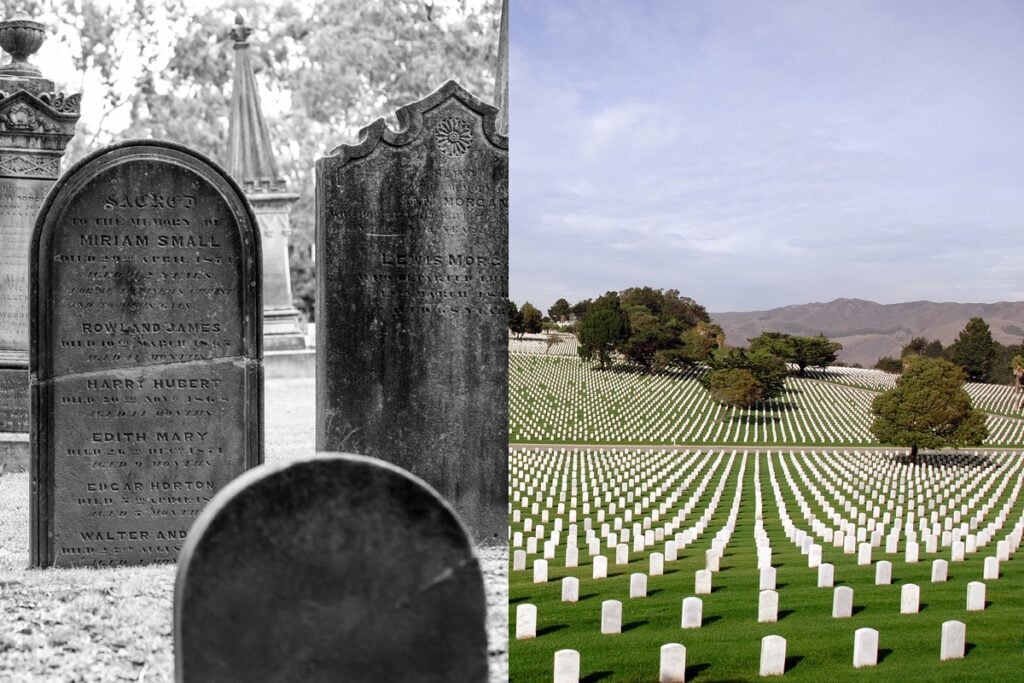Many people use the terms “cemetery” and “graveyard” interchangeably, but these two words have distinct meanings rooted in history and religious practices. Understanding these differences can provide clarity when discussing burial practices and assist in making informed decisions about final resting places.
Definition and Origin
Understanding the basic definitions and historical roots of cemeteries and graveyards is essential to grasp their differences. Below, we explore what sets these two terms apart and how their usage has evolved over time.
Cemetery
A cemetery is a plot of land designated for burials, usually independent of a church. The word “cemetery” comes from the Greek koimeterion, meaning “sleeping place,” emphasizing its secular and inclusive nature. Cemeteries can be public or privately owned, accommodating people of various faiths or none at all.
Graveyard
A graveyard is a burial ground traditionally attached to a church. This association dates back to medieval times when local churches maintained burial grounds for their parishioners. Graveyards are usually smaller than cemeteries and possess a distinctly religious character, often reserved for those affiliated with the church.
Key Differences Between a Cemetery and a Graveyard
Here are the key differences for cemetery vs graveyard.
| Aspect | Cemetery | Graveyard |
|---|---|---|
| Location | Standalone burial ground | Attached to a church |
| Religious Ties | Non-denominational or multi-faith | Usually serves church members |
| Size | Larger and often expandable | Smaller, limited by church property size |
| Design | Often landscaped with modern memorials | Older, with historic and traditional layouts |
| Historical Use | Modern, designed for larger populations | Predominantly medieval and colonial use |
Historical Context: Cemetery vs Graveyard
In the Middle Ages, churches were central to community life, and their grounds served as the primary place for burials. As towns expanded and populations grew, church graveyards quickly became overfilled. This led to the development of larger, non-religious burial grounds, or cemeteries, that could accommodate more graves and different practices.
Graveyards typically reflect their centuries-old history with weathered headstones and smaller, often irregularly spaced plots. Cemeteries, however, evolved with modern needs in mind, incorporating planned paths, sections for different types of interments, and features like mausoleums.
Cultural Perspectives
The cultural importance of cemeteries and graveyards can vary. In Europe, graveyards attached to churches are often valued for their historical and architectural significance. Cemeteries in North America tend to cater to a wider audience, embracing modern burial practices and multi-faith inclusivity. The rise of eco-friendly burials has also influenced the way cemeteries are designed, focusing more on sustainable practices and natural environments.
Famous Examples
- Graveyard Example: St. Peter’s Church Graveyard in Philadelphia, Pennsylvania, is known for its historical significance and colonial-era burials. It embodies the traditional, church-associated character of a graveyard.
- Cemetery Example: Arlington National Cemetery in Virginia is a prominent military burial site. Its vast, meticulously maintained grounds reflect its modern, non-denominational design.
Notes on Terminology in Different Cultures
Terminology and cultural distinctions vary by region. In British English, “churchyard” is commonly used in place of “graveyard,” emphasizing the connection to a church. In the U.S. and Canada, “cemetery” has become the more common term, encompassing burial grounds that serve various purposes and communities.
Frequently Asked Questions: Cemetery vs Graveyard
Here are frequently asked questions and their answers about this topic.
What are the main differences between a cemetery and a graveyard?
Cemeteries are large, independent burial grounds that cater to various religious and secular communities. Graveyards are smaller and attached to churches, serving primarily religious congregations.
Why are graveyards often smaller than cemeteries?
Graveyards are limited by the size of church properties, which restricts their expansion. Cemeteries, however, are designed for growth and can cover vast areas.
Are graveyards still used today?
Yes, graveyards continue to be used, especially by churches with sufficient land. However, most modern burials occur in cemeteries due to their size and non-religious nature.
Can anyone be buried in a graveyard?
Typically, graveyards are reserved for members of the associated church or religious community. Policies on who can be buried vary by church.
Do cemeteries have religious ties?
Cemeteries are generally non-denominational, accommodating people of all beliefs or none. While some cemeteries may be associated with religious organizations, they are more flexible than graveyards.
What regulations govern cemeteries and graveyards?
Cemeteries are often governed by municipal or private regulations, while graveyards fall under church and local authority rules.
Why do cemeteries often have landscaped designs?
Cemeteries are planned with modern principles in mind, often incorporating landscaped paths, memorials, and serene environments for visitors.
Are cremated remains interred in graveyards?
Yes, many graveyards accept cremated remains, especially as space becomes more limited and cremation becomes more common. See also: Burying ashes in the U.S.
What is the oldest known cemetery?
The oldest known formal cemetery is the Taforalt Cave in Morocco, dating back about 15,000 years, although ancient burial grounds existed across different civilizations.
How have cemeteries adapted to modern needs?
Cemeteries have evolved by including options like eco-friendly burial sites, digital memorials, and spaces for various cultural and religious practices.

